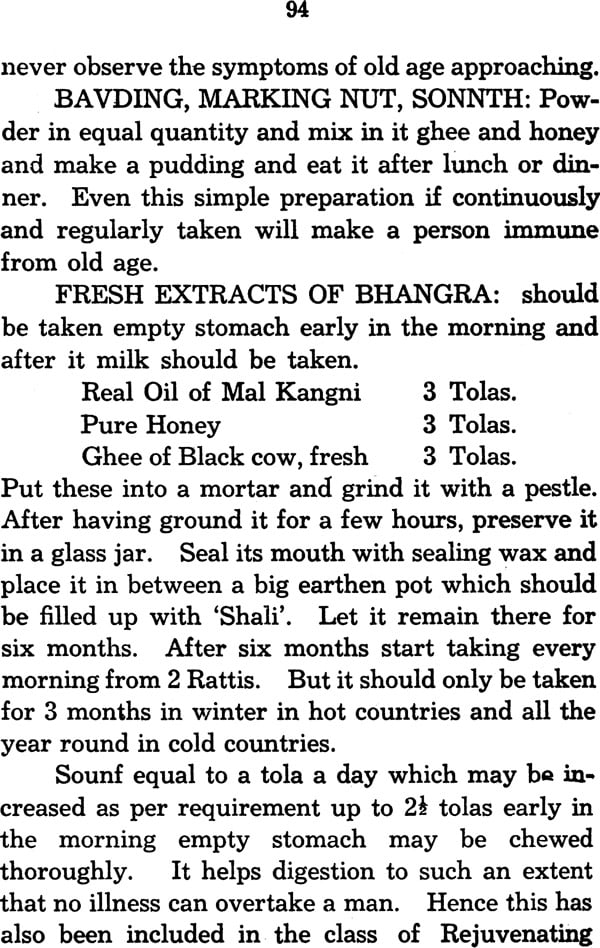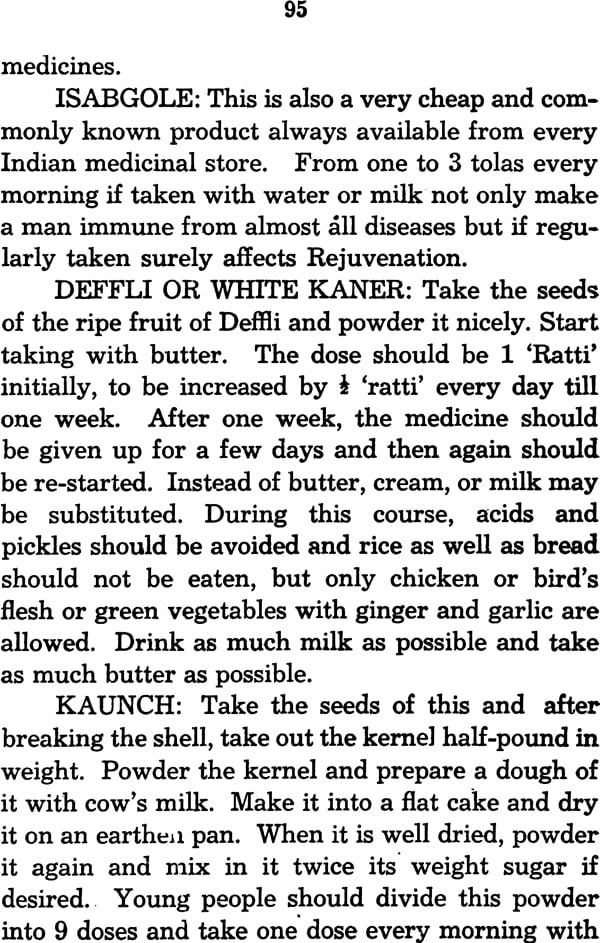
Kaya-Kalap (Science of Rejuvenation)
Book Specification
| Item Code: | NAN385 |
| Author: | Dr. Sun Mukh S. Yogi |
| Publisher: | Chowkhamba Krishnadas Academy |
| Language: | English |
| Edition: | 2014 |
| ISBN: | 9788121801575 |
| Pages: | 104 |
| Cover: | Paperback |
| Other Details | 7.0 inch X 4.5 inch |
| Weight | 70 gm |
Book Description
The science of 'Kayakalap' or 'Rejuvenation' has received the attention of some of the most eminent physiologists and doctors ever since the Vedic period. The development of this science has been along lines which are very well recognised in the Ayurvedic system of medicine. Perhaps it would not be wrong to say that the very fact that Ayurveda recognised a certain system of treatment which embraced the simultaneous revival of the important organs of the body, has made the development of 'Kayakalap' up to its present standard possible. The term "present standard" may perhaps be misleading and it would be worthwhile making it clear; that by "present standard" is meant the standard which it achieved at its height. It may be that at present we do not know certain aspects owing to researches remaining incomplete and the consequent back-sliding.
In this book we propose to mention the theory that the present day Allopathic system of medicine is based 'on the same elements as the Unani system that was at its height in India during the Moghul period. This is the same system that was practised by some of the well-known Greek sages and the Elixir of Life which has been so often heard of was one of their main objectives. There is no doubt that for this Elixir of Life great researches were made and many a learned man devoted his life to find it and give to the world life everlasting. It is equally true, however, that whatever progress was made has either been lost or it was so meagre that it was not considered worth preserving. In any case the hypothesis on the basis of which this Elixir of Life was sought by the Western people seems to have been fundamentally different from that of 'Kayakalap', and this may perhaps account for the tangible results that exist today in the case of the latter.
In the West it seems that efforts were made on the assumption that there did exist in this universe, either as an element or as a compound, some kind of matter which, if introduced into the life-stream of human bodies, had the effect of making it immune from the destructive influences of nature. Obviously, therefore, more attention was paid to the discovery of the requisite elements than to human anatomy. The deterioration and decline of the human faculties was no doubt a phenomenon well-known to the sages of the Greek and Roman civilisation, but it seems that their efforts were not applied towards the checking of this decline, as much as towards the discovery of something which would make such a decline disappear altogether.
In Ayurveda, on the contrary, all efforts have been directed towards the checking of the decline of the human faculties and it has been always believed that the utmost success that could be achieved in this direction would be to retard the action of decay, and decline for a certain period. With a view to bring about this result, minute attention has been paid to human anatomy and all those influences which have a bearing on its development and decline. Of the two, therefore, we have, no hesitation in finding that Ayurveda and the researches that have been carried out under its, guidance have been by far the more scientific and accurate.
This fact, it seems, was recognised by the Unani system, particularly when it came into sharp conflict with the Ayurvedic system in India. As a result, some of the well-known physicians who have practised this system have applied themselves assiduously to evolve some method parallel to 'Kayakalap'. There is no doubt that their efforts have met with considerable success but it is a pity that that knowledge which they succeeded in acquiring after vast efforts has not been preserved' as accurately as it should have been. Anyhow, the fact remains that they were able to bring about a system by which the degeneration and decline of the bodily powers of human beings were considerably retarded.
Today the West and its institutions are so pre-dominant that whatever progress had been achieved by the old sciences in the East has been sadly neglected in consequence of which some of the advantages which were available to our forefathers in India have been lost. This observation has been confirmed over and over again during the course of the writer's contact with thousands .of people all over the country. In the field of medicine, there is a great scope for systems which can help to set right the mistakes of individuals in modern society. But advantage is not taken of them on account of certain new-fangled ideas which have been advocated by the Allopathic physicians. It does not stand to reason that where a certain malady having a limited scope can be cured, the same disorder should become incurable when it affects the general morale of the body. Moreover, it also seems to be unreasonable that, whereas the actual maladies are curable, it should not be possible to tone up the system generally or to assist nature to bring it up to an average standard.
The writer has had considerable experience of cases where a little assistance would set matters right and would give a new lease of life to an individual, but that assistance is either not available at all or is cloaked in such mystery that he is afraid of applying for it. Moreover the expense requisite to obtain the benefit of a recognised system of rejuvenation on correct lines is almost prohibitive.
It is hoped that the recording of some of the aspects of the science of revitalising and reviving the energies of human beings would help to convince them of the possibility of their regaining lost ground and would place the same within easy reach of average men and women.









